NEWS
08/06/2022 Direct Measurement of the Magnetic Moment of a Singe 3He+ Ion
Helium-3 has nowadays become one of the most important candidates for studies in fundamental physics, nuclear and atomic structure, magnetometry and metrology, as well as chemistry and medicine. In particular, 3He nuclear magnetic resonance (NMR) probes have been proposed as a new standard for absolute magnetometry. This requires a high-accuracy value for the 3He nuclear magnetic moment, which, however, has so far been determined only indirectly and with a relative precision of 12 parts per billion. In a collaboration with the Max Planck Institute for Nuclear Physics, performed within the MPG, RIKEN, PTB Center for Time, Constants and Fundamental Symmetries, we have investigated the ground-state hyperfine structure of a single 3He+ ion in a Penning trap, results were published today in Nature. (https://www.nature.com/articles/s41586-022-04761-7) Our measured value for the 3He+ nuclear g-factor enables the determination of the g-factor of the bare nucleus g=−4.2552506997(30)stat(17)sys via our accurate calculation of the diamagnetic shielding constant. This new result constitutes a direct calibration for 3He NMR probes and an improvement of the precision by one order of magnitude compared to previous indirect results.
Figure1 result of the current work compared to previous indirect measurements: for further reading see https://www.nature.com/articles/s41586-022-04761-7
Based on ideas of Harikrishnan Ramani and Peter Graham (Stanford University), we contributed to a manuscript that was published today
PRX-Quantum, in which we use trapped charged particles in strong magnetic bottles for the detection of millicharged particles (MCPs). These MCPs constitute a well-motivated extension of the Standard Model of Particle Physics, and are excellent candidates for dark matter. The hypothetical MCPs scatter off the trapped ions, giving a signal either in individual events or in the overall heating rate of the ions. Ion traps have several properties that make them ideal detectors for such signals. First, we have demonstrated significant isolation of the trapped particles from the environment, and have reported on measured background antiproton cyclotron-heating-rates as low as 6 induced quantum transitions per hour of observation time. Second, single particle in Penning traps have low thresholds for the detection of energy deposition, down to the nano-electron-volt range. Third, since the trapped particles are charged, they naturally have large cross sections for scattering with the MCPs, this being further enhanced by the low velocities of the thermalized MCPs. Despite ion-trap setups being optimized for other goals, for example high precision comparisons of the fundamental properties of matter/antimatter conjugates (https://doi.org/10.1038/s41586-021-04203-w), we find that existing measurements put new constraints on millicharged dark matter that are many orders of magnitude beyond previous bounds. For example, for a millicharged dark matter mass of 10GeV and a charge of 0.001 the electron charge, ion traps limit the local MCS density to be smaller than 1 par cubic centimeter, a factor of approximately eight orders of magnitude better than constraints from accelerator based experiments and astrophysical observations. Future dedicated ion-trap experiments could reach even further into unexplored parameter space.
Figure 1: Limits on the existence of MCPs derived from different trap experiments. The measurements of BASE, using a single antiproton in a Penning trap with a strong superimposed magnetic bottle are covered in blue. > In a paper published today in Nature, we report on the most precise comparison between a fundamental property of protons and antiprotons. Analysing a total of about 24000 proton and antiproton cyclotron frequency measurements, taken over the course of one year and half, we found that the charge-to-mass ratios of protons and antiprotons are identical to within a record experimental uncertainty of 16 parts per trillion, see Fig. 1. This measurement constitutes the most precise test of the fundamental charge, parity, time reversal invariance, which is at the level of known fundamental physics the only combination of discrete symmetry transformations that is observed as an exact symmetry of nature. The detection of a mass difference between matter/antimatter conjugates would imply higher-dimension physics with non-local character. Our result means that at the level of an energy resolution of 2x10-27 GeV we do not detect any indication of such type of physics beyond the Standard Model, which would violate fundamental principles, such as microcausality and Lorentz invariance. The experimental detection of such a difference could also shed light on why the universe is made up almost entirely of matter, even though to our current best knowledge equal amounts of matter and antimatter should have been created in the Big Bang. The detected differences between matter and antimatter particles that are consistent with the Standard Model are by many orders of magnitude insufficient to explain this observed cosmic imbalance. Figure 1: Elements of the proton/antiproton Q/M ratio comparison. Distribution of measured data points projected to one sidereal year. Our measurements are based on the operation of an advanced cryogenic Penning trap system in which we confine antiprotons and negatively charged hydrogen ions as proxies for protons. A particle in such a trap follows a cyclical trajectory with a frequency, close to the cyclotron frequency, that scales with the trap’s magnetic-field strength and the particle's charge-to-mass ratio. Alternately feeding antiprotons and negatively charged hydrogen ions into the measurement Penning trap, we measured, under the same conditions, the cyclotron frequencies of these two kinds of particles and obtained the above result.
In addition to comparing fundamental properties of protons and antiprotons with unprecedented precision, we have interpreted our measurements in a way that allows us to place stringent limits on the weak equivalence principle for matter and antimatter clocks. According to this principle, different bodies in the same gravitational field experience the same acceleration. Because our experiment is placed on the surface of the Earth, the proton and antiproton cyclotron-frequency measurements were made in the gravitational field on Earth’s surface. Sampling the varying gravitational field in our laboratory as the planet orbits around the Sun, if matter and antimatter would react differently to gravity, we should observe time dependent signatures in the measured proton/antiproton cyclotron-frequency ratios. Within a measurement uncertainty at a level of three parts in 100 we did not find such oscillating signatures. This study constitutes the first differential test of the weak equivalence principle for baryonic matter/antimatter clocks, the result indicates, within the achieved experimental resolution, that matter and antimatter clocks behave similar under gravity.
One of the highlights in the annual Physics calendar is the announcement of the “Physics Breakthroughs of the Year”, by the journal Physics World. This year, our paper on "Sympathetic cooling of protons mediated by a superconducting LC-circuit", published in Nature, was selected as one of the top ten achievements made in 2021. According to Physics World, the selections must meet the following criteria:
Our paper was nominated in combination with work by our colleagues from the ALPHA collaboration, which demonstrated for the first time cooling of antihydrogen atoms. Both efforts together are nominated for “the development of innovative particle cooling techniques”. Other related breakthroughs on the list are the muon g-2 experiment at Fermilab and their improved measurement of the muon magnetic moment anomaly, the event horizon telescope collaboration and their first image showing the polarization of light in the region surrounding a supermassive black hole, and the observation of Pauli blocking in ultracold gases of fermionic atoms. For the full list of finalists follow this link. Here is a share of the nomination, copied from the Physics World website:
Innovative particle cooling techniques To researchers from the Antihydrogen Laser Physics Apparatus (ALPHA) and the Baryon Antibaryon Symmetry Experiment (BASE) collaborations at CERN, for two separate studies presenting new ways to cool particles and antiparticles. The techniques could pave the way for precision studies examining the matter–antimatter asymmetry in the universe. The ALPHA collaboration demonstrated for the first time. To achieve this, the physicists developed a new type of laser, which produces 121.6 nm laser pulses, to cool the antiatoms. They then measured a key electronic transition in antihydrogen with unprecedented precision, a breakthrough that could lead to improved tests of other key properties of antimatter. The BASE researchers, meanwhile, showed how to extract heat from a single proton" via a superconducting circuit connected to a cloud of laser-cooled ions several centimetres away – a technique, they say, that could easily be applied to antiprotons. Today, we report in Nature on the first sympathetic cooling of a single trapped proton, using laser-cooled beryllium ions stored in a spatially separated trap. The energy exchange between the proton and the laser-cooled ions is mediated by image currents induced by the ions in the trap electrodes, transmitted through a superconducting LC circuit that connects the traps (see Figure 1). In our first demonstration of this method, we cool the proton to a temperature about one order of magnitude lower than the cooling limit of routinely used resistive cooling methods (see Figure 2). Figure 1: Concept of the experimental setup. Cooling of trapped particles is essential for any kind of trap-based high-precision measurement, since higher particle temperatures increase the uncertainty of the measurement and lead to larger systematic shifts of the measured results. In that light, any idealized high-precision study would utilize particles at energies close to the quantum ground state, which can be realised using laser cooling. However, laser cooling can only be applied to a small number of (mostly positive) atomic ions, and cannot be directly applied to fundamental particles like protons and antiprotons. Heinzen and Wineland therefore proposed a technique to transfer laser cooling from a suitable ion species via image currents to a separate trap. Independent of optical properties, this method can be applied to any kind of charged particle, even exotic particles such as antiprotons, highly-charged ions, or molecular ions. Figure 2 : Sympathetic Cooling – achieved proton temperatures as a function of the number of Be ions stored in the “cooling trap” We are driven to incorporate this technique in our advanced Penning traps to improve the comparison of the proton and antiproton magnetic moments, and so better understand the matter/antimatter imbalance in our Universe. For these measurements, protons and antiprotons at energies of about 100 mK are required. Only with particles at such low temperatures single spin transitions can be observed – an essential prerequisite for measurements on nuclear magnetic moments. To prepare such cold particles by established resistive cooling methods is time-consuming; the newly demonstrated method is a first essential milestone to improve these classical limits.
One experimental challenge of implementing these techniques into our trap system is that the image currents induced in the trap electrodes are tiny. To overcome this problem, we use a tuned superconducting circuit that amplifies the image currents, which enhances the energy exchange rate between the laser-cooled ions and the proton. Using this “superconducting spring”, we successfully observed the first sympathetic cooling of a single trapped proton by laser-cooled ions. This advance adds new technology to the basic methods-set of precision Penning-trap spectroscopy, and has the potential to improve future measurements of the proton/antiproton magnetic moments considerably. For details see24/02/2022 Millicharged Dark Matter Detection with Ion Traps
06/01/2022 A 16 parts-per-trillion comparison of the proton/antiproton charge-to-mass ratios

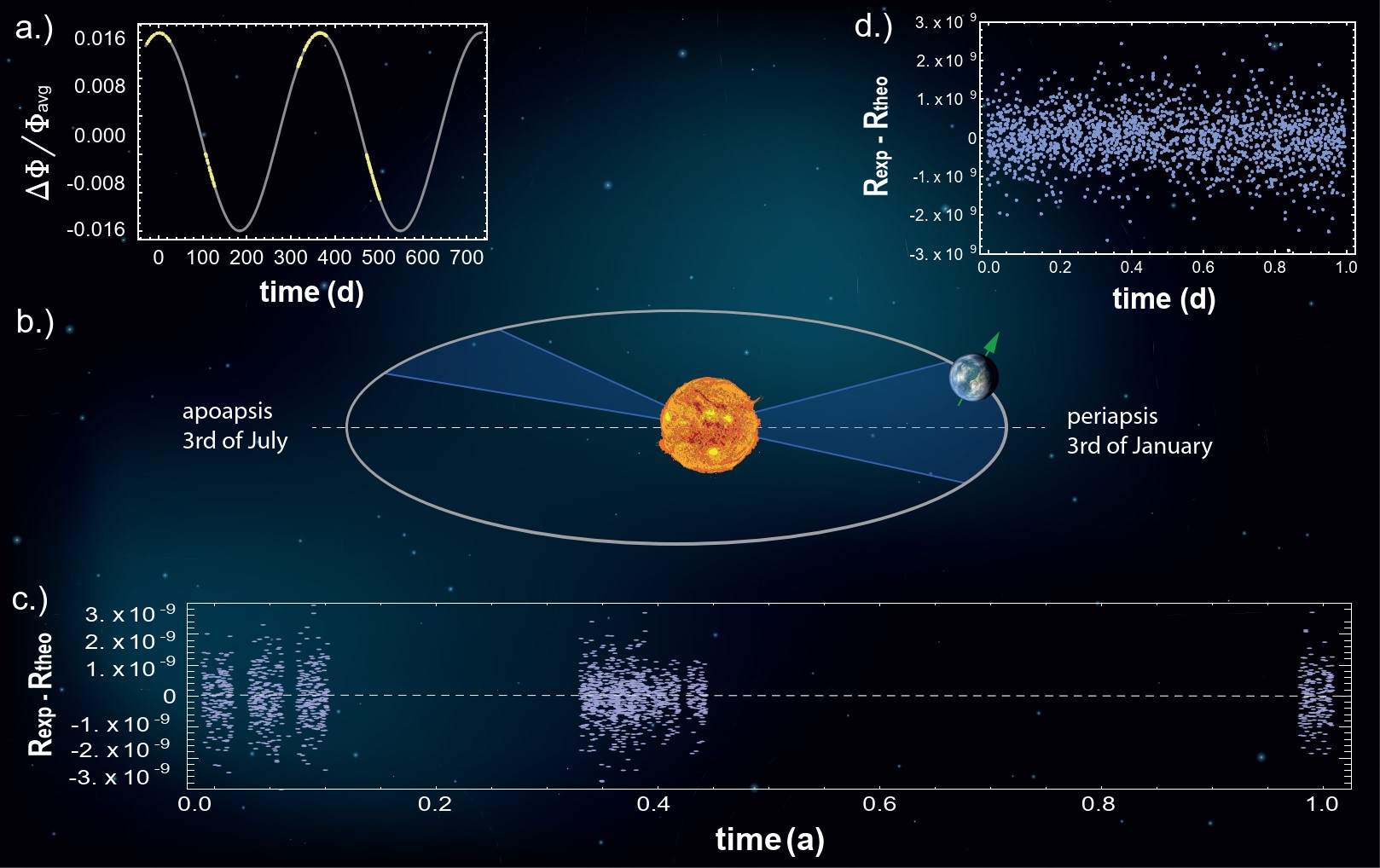
08/12/2021 BASE and ALPHA in the Top 10 of Physics Breakthroughs 2021
25/08/2021 COOL NEW TECHNIQUE: SYMPATHETIC COOLING OF PROTONS BY LASER-COOLED BERYLLIUM IONS

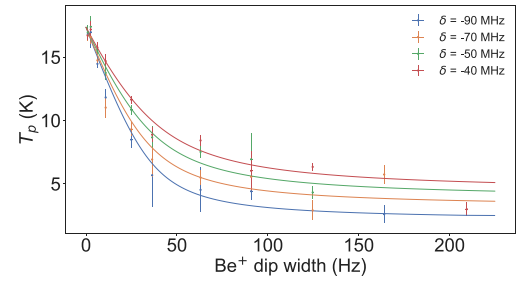
25/01/2021 A New Tool in the Search for Axions and Axion-Like-Particles
Today we report in Physical Review Letters on a new method to constrain the conversion of axion-like particles into photons, measured using the superconducting resonant single particle detection circuit of one of our cryogenic Penning traps. By searching the noise spectrum of our fixed frequency resonant circuit for peaks caused by axion-to-photon conversion in the strong magnetic field of the Penning trap magnet, we are able to constrain the coupling of ALPs with masses around 2.7906-2.7914 neV to be gag<1 *10-11/ GeV. This is more than one order of magnitude lower than the best laboratory haloscope and approximately five times lower than the CAST helioscope, setting limits in a mass and coupling range thatis not constrained by astrophysical observations. This approach can be extended to many other Penning trap experiments, and has the potential to provide stringent high-resolution limits in the low ma range. Using the existing technologies available in BASE and developing a purpose-built experiment, the detection bandwidth could be increased by a factor of >1000 at about 200-fold improved detection sensitivity.
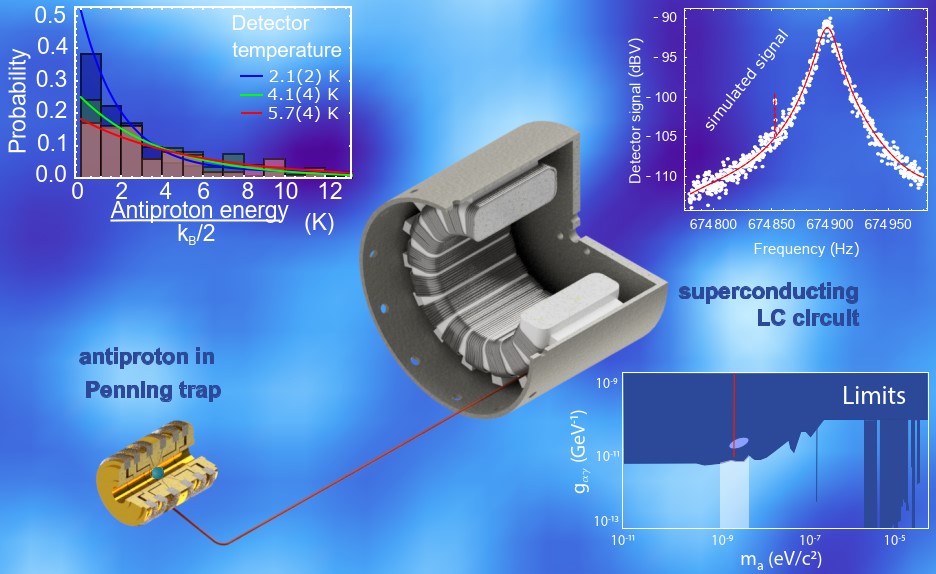
07/05/2020 Pentatrap
State-of-the-art optical clocks achieve precisions of 10−18 or better using ensembles of atoms in optical lattices or individual ions in radio-frequency traps. Promising candidates for use in atomic clocks are highly charged ions (HCIs) and nuclear transitions, which are largely insensitive to external perturbations and reach wavelengths beyond the optical range that are accessible to frequency combs. However, insufficiently accurate atomic structure calculations hinder the identification of suitable transitions in HCIs. In collaboration with the group of Klaus Blaum of the Max Planck Institute for Nuclear Physics (MPIK), Heidelberg, Germany, and within the Max Planck, RIKEN, PTB Center for Time, Constants and Fundamental Symmetries, RIKEN Fundamental Symmetries Laboratory contributed to a study, which reports on the observation of a long-lived metastable electronic state in a highly charged ion, by measuring the mass difference between the ground and excited states in rhenium. This measurement provides a non-destructive, direct determination of an electronic excitation energy of the exotic HCI-state. The result is in agreement with advanced calculations, which are also presented in the paper. The experimental study was performed using the high-precision Penning trap mass spectrometer PENTATRAP, which is located at MPIK. Using this elegant 5-trap instrument, the cyclotron frequency ratio of the ground state to the metastable state of the trapped Rhenium ions was measured with a precision of 10−11—an improvement by a factor of 10 compared with previous measurements. With a lifetime of about 130 days, the potential soft-X-ray frequency reference at 4.96 × 1016 Hz has a linewidth of only 5 × 10−8 Hz, which corresponds to a transition energy of about 200 eV. So far, this is one of the highest electronic quality factors ever measured experimentally. The low uncertainty of the applied method will enable searches for further soft-X-ray clock transitions in HCIs, which are required for precision studies of fundamental physics.
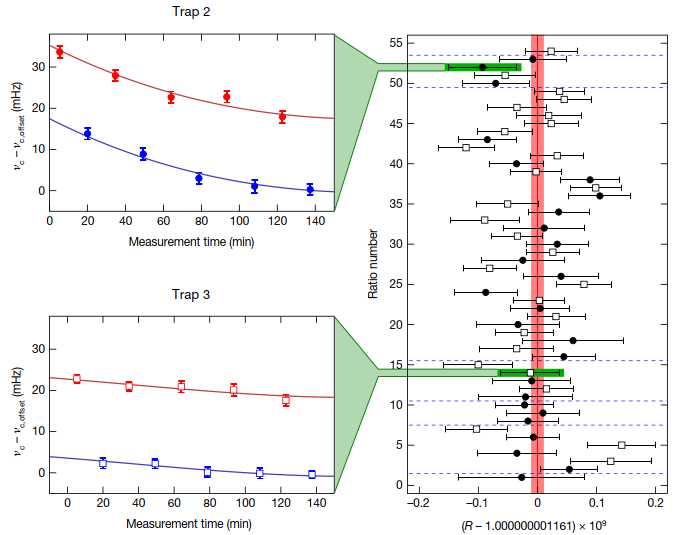
14/11/2019 Direct Limits on the Interaction of Antiprotons with Axion-Like Dark Matter
Today we published the first limits on the interaction of antiprotons with axion-like dark matter. For this work we’ve teamed up with scientists from the PRISMA+ cluster at Mainz and the Kavli Institute for Physics and Mathematics of the Universe, which have great expertise in dark matter research.
Astronomical observations tell us that dark matter makes up most of the matter in the cosmos but we do not know what it is made of. Additionally, theories of the early universe predict that both antimatter and matter should have been produced in equal amounts, yet for some reason matter prevailed. Could there be a relation between matter–antimatter asymmetry and dark matter? To investigate that question, we’ve performed the first explicit laboratory search for an interaction between antimatter and axion-like particles. Using the two particle/three trap method invented in our lab we’ve measured the antiproton magnetic moment with a fractional precision of 1.5 parts in a billion. We’ve analyzed the resulting g-factor resonance for oscillatory signatures which –would be induced by dark matter interactions. This type of data treatment enabled us to extract the first direct limits on the coupling between axion like particles and antiprotons.
Our analysis constrains the axion–antiproton interaction parameter to values greater than 0.1 to 0.6 GeV in the mass range from 2 × 10-23 to 4 × 10-17eV, corresponding to a g-factor resonance modulation with an amplitude of 5 p.p.b. to 10 p.p.b., in a frequency range from 200 mHz to 0.1 µHz. This improves the sensitivity of antiproton/axion coupling by up to five orders of magnitude compared with astrophysical bounds. In addition, we derive limits on six combinations of previously unconstrained Lorentz- and CPT-violating terms of the non-minimal standard model extension.
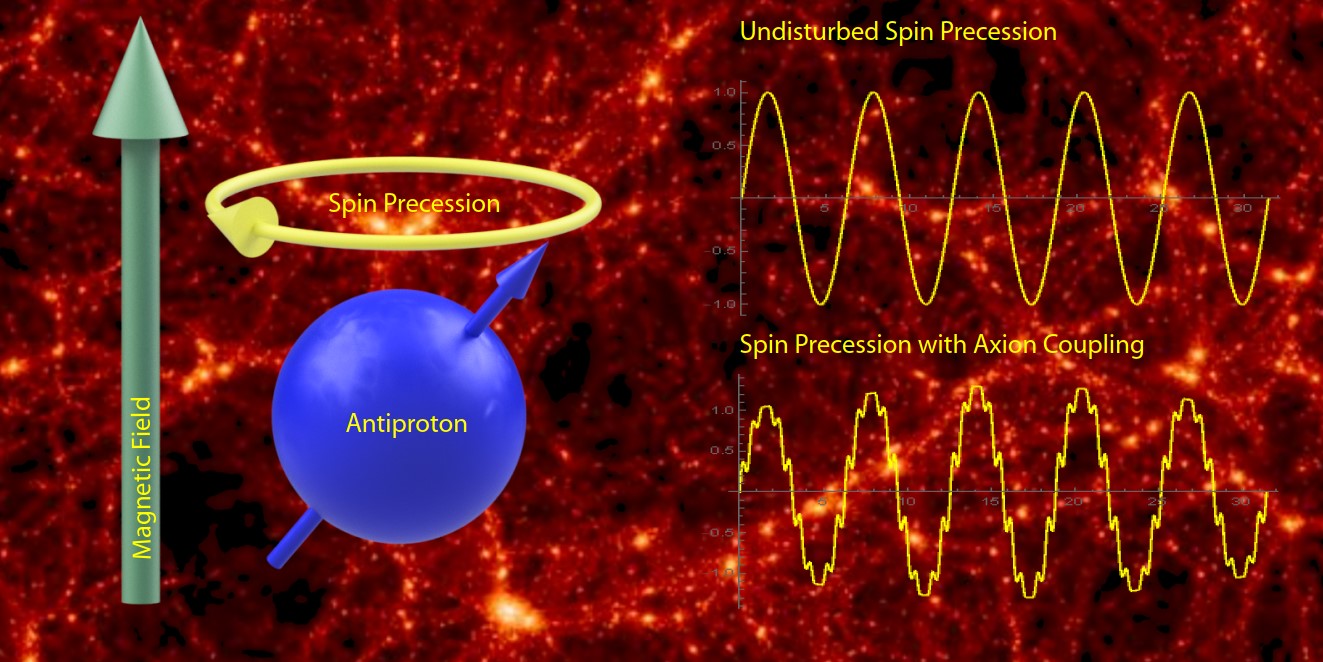
For details see
10/04/2019 Superconducting Solenoid System with Adjustable Shielding Factor for Precision Measurements of the Properties of the Antiproton
Today we published a new paper in Physical Review Applied, on an innovative, tunable magnetic shielding system. With the tuned system, we suppress external magnetic field disturbances by up to a factor of 225 ± 15. Together with other developments, this will enable future antiproton-to-proton charge-to-mass ratio comparisons with fourfold reduced frequency fluctuations and antiproton magnetic moment determinations with about tenfold reduced uncertainty. With the tuned system, we suppress external magnetic field disturbances by up to a factor of 225 ± 15. Together with other developments, this will enable future antiproton-to-proton charge-to-mass ratio comparisons with fourfold reduced frequency fluctuations and antiproton magnetic moment determinations with about tenfold reduced uncertainty.
For details see
07/16/2019 IUPAP Prize for Atomic, Molecular, and Optical Physics 2019 awarded to BASE members Christian Smorra and Andreas Mooser
The IUPAP Prize for Atomic, Molecular, and Optical Physics 2019 was awarded to the BASE members Christian Smorra (RIKEN and CERN) and Andreas Mooser (RIKEN and MPIK). The highly competitive research prize was awarded…
“…for outstanding contributions to determine the most precise comparison of the proton-to-antiproton charge-to-mass ratios and the most precise comparison of the proton and antiproton magnetic moments, constituting two different world-record tests of the fundamental charge, parity, and time reversal symmetry in these systems.”
We congratulate Christian and Andreas with pleasure to this great success!!!
Christian Smorra joined the RIKEN group in BASE as a post-doc in 2012, within his work he designed major parts of the BASE apparatus, contributed to the high-precision measurement of the proton-to-antiproton charge-to-mass ratio, and the invention and commissioning of the BASE reservoir-trap method. In 2017, in the framework of a CERN-fellowship, he published a 1.5 p.p.b. measurement of the magnetic moment of the antiproton using a newly invented two-particle / three trap method. This result improves upon previous best competing Penning trap efforts by more than a factor of 3000. In 2018 he became co-spokesperson of the BASE collaboration, still being a member for RIKEN Fundamental Symmetries Laboratory, within this position he is currently leading the BASE-Mainz experiment.
Andreas Mooser performed the first direct high-precision measurement of the magnetic moment of the proton with a fractional precision of 3.3 p.p.b.. He joined BASE’s RIKEN group in 2014 in the framework of a competitive RIKEN FPR fellowship, and was working at BASE-CERN in the 2014/2015 antiproton runs. As a RIKEN fellow he continued working at BASE-Mainz until 2018, under his supervision the Mainz team improved the precision of the proton magnetic moment to the level of 300 p.p.t. and started implementing methods to sympathetically cool protons with laser cooled Be+ ions. Since 2018 he is leading a Max Planck/RIKEN research group at the Max Planck Institute for Nuclear Physics in Heidelberg, Germany, in the framework of the MPG-RIKEN-PTB Center for Time, Constants and Fundamental Symmetries.
The award of the prize is without any doubt a great honour for the BASE collaboration, however only possible thanks to the strong and very generous support by RIKEN (Japan), the Max Planck Society (Germany), and CERN (Switzerland). We would like to thank the fantastic AD-operators team, CERN’s engineering departments, CERN’s cryolab for the everlasting and reliable support, and all the other CERN groups which are supporting us.
08/04/2019 Center for Time, Constants, and Fundamental Symmetries
Today we’ve celebrated the inauguration of the Max-Planck/PTB/RIKEN Center for Time, Constants and Fundamental Symmetries, the event took place at RIKEN’s Wako-Campus in Japan. We’ve organized a symposium with invited speakers Marianna Safronova (Univ. Delaware) and Yoshiro Takahashi (Kyoto University), and center speakers Klaus Blaum (MPG), Ekkehard Peik (PTB), and Stefan Ulmer (RIKEN). Guests like Prof. M. Stratmann (President MPG), Prof. J. Ullrich (President PTB), Prof. S. Koyasu and Prof. M. Kotani (RIKEN Executive Directors), and Dr. H. von Werthern, the ambassador of Germany in Japan, joined the event. By supporting this center, the three research institutions put critical momentum into ultra-high precision physics and tests of fundamental symmetries. The BASE collaboration - in which the three institutions are already united to perform high-precision antiproton experiments - played an important role in the approval process of the project, and will considerably profit from this new initiative. BASE projects within the center are the development of transportable antiproton traps and continued efforts to develop methods for the sympathetic cooling of antiprotons.
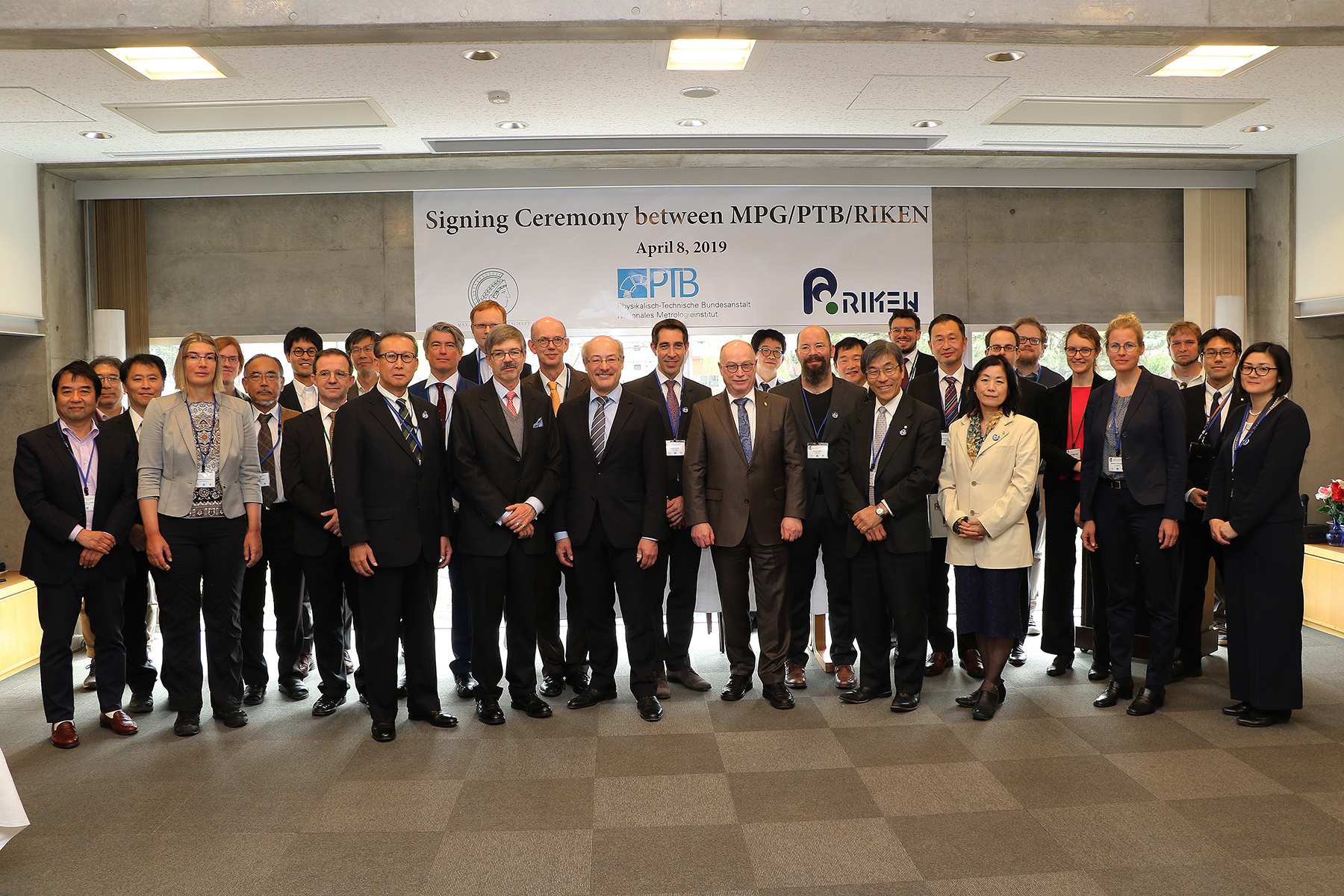
01/28/2019 First explicit measurement of heating rates in a cryogenic Penning trap
Today we report on the first measurement of cyclotron quantum heating rates in a cryogenic Penning trap. We demonstrate that the scaled electric field noise in our spin-analysis trap, an essential instrument in our 1.5 p.p.b. measurement of the antiproton magnetic moment, is much lower than observed in other ion trap experiments. It corresponds to a heating rate below 0.1 quanta per hour and a radial energy stability on the peV/s-level.
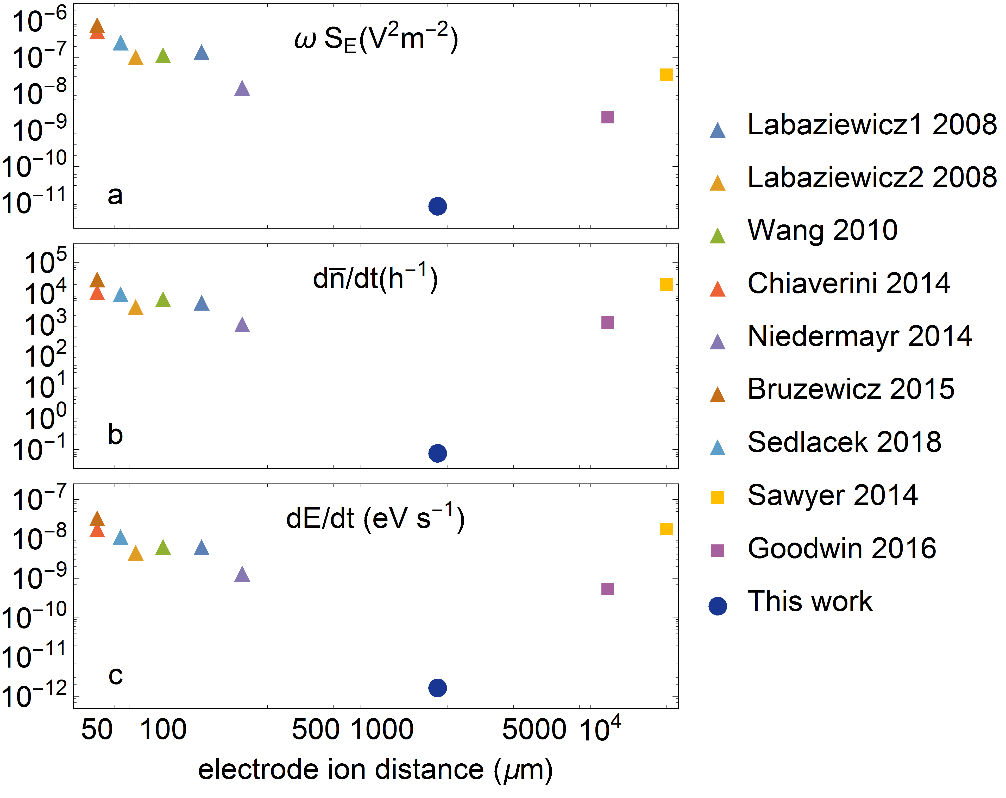
Figure 1: Comparison of scaled field noise (a), heating rate (b) and energy heating rate (c) of various ion trap experiments plotted versus electrode ion distance. Triangles represent results from cryogenic Paul traps, squares from room temperature Penning traps. The result of our work is displayed as a blue circle.
Cyclotron transition rates were measured by employing the continuous Stern-Gerlach effect, which couples the radial quantum states to the axial motion of a trapped antiproton. By evaluating the axial frequency stability and comparing it to noise driven random walks in the cyclotron motion, we extract absolute transitions rates of 6(1) cyclotron quanta per hour and a heating rate below 0.1 quanta per hour. For the electric field noise in our trap, we obtain an absolute noise spectral density at the 10-20V2/(m2Ηz)-level and a scaled noise density below 10-11V2/m2. Compared to Paul-trap and room temperature Penning-trap experiments, the scaled field noise in our cryogenic Penning trap setup is by more than two orders of magnitude smaller. To understand the origin of these electric field fluctuations, we conducted heating rate measurements at various particle orbits, corresponding to different positions in the trapping potential. Based on these measurements we identified residual trap potential fluctuations as the dominant source of electric field noise in our experiment. Effects of anomalous heating imposed by fluctuating patch potentials were not resolved within the measurement precision.
For details see
11/23/2017 11-fold improved measurement of the proton magnetic moment
Today we report in SCIENCE (Link to publication) on a new measurement of the proton magnetic moment in units of the nuclear magneton. The updated value gp/2=2.792 847 344 62 (82) is consistent with our previous best measurement, but improves the precision by a factor of 11. The measurement was carried out using an optimized double Penning trap technique, compared to our 2014 measurement, a trap with higher magnetic field stability and homogeneity was implemented. Together with a significantly improved cooling system for the preparation of sub-thermal cyclotron quantum states and an optimized spin transition drive method, the 11-fold improved measurement became possible.
This new result improves, together with our recent measurement of the antiproton magnetic moment (link to Smorra Nature) gpbar/2=2.792 847 344 1 (42), the test of the fundamental charge, parity, time invariance by a factor of two, still being CPT consistent. The result reported here is an important step towards further advancing the precision in CPT-tests, the application of the optimized double Penning trap method to the antiproton will improve direct tests of CPT invariance in the magnetic moment sector by a factor of 5.
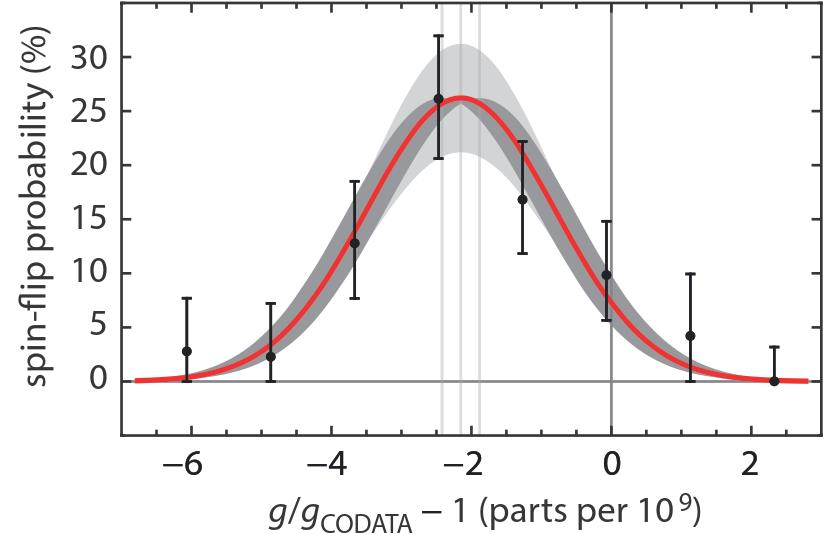 |
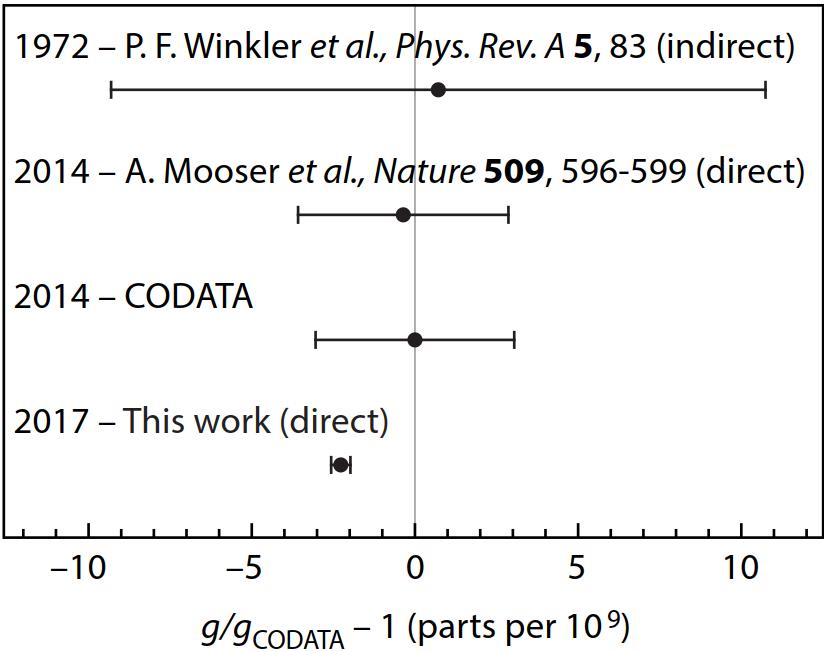 |
10/19/2017 A parts per billion measurement of the antiproton magnetic moment
Today we report on an improved measurement of the magnetic moment of the antiproton. The new measurement outperforms our old record measurement by a factor of 350 in experimental precision. Our updated value μρ̄ = -2.792 847 344 1 (43) μΝ is consistent with the magnetic moment of the proton μρ= 2.792 847 350 (9) μΝ’ and thus supports the combined charge, parity, and time-reversal (CPT) invariance, an important symmetry of the Standard Model of particle physics. Remarkably, this is the first time physicists have carried out a more precise measurement on antiprotons than on protons. Together with the exciting new antihydrogen results, this milestone achievement is a demonstration of the immense progress made at CERN’s antiproton decelerator facility. This extraordinary improvement in experimental accuracy was made possible by the invention of a novel two-particle multi-Penning-trap measurement method, developed at Ulmer FSL, which combines the non-destructive detection of the antiproton’s spin quantum state with particle-based high-resolution magnetic field measurements.
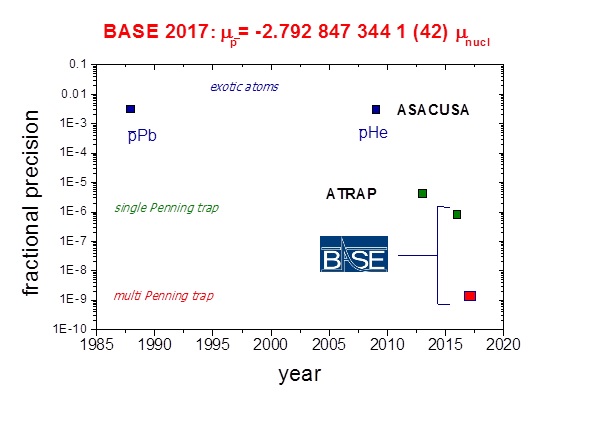
The determination of the magnetic moment of a single trapped particle is based on the measurement of two characteristic frequencies. The first is the cyclotron frequency νc, which describes the particle’s revolutions per second in the magnetic field of the Penning trap, and the second, the precession frequency νL of the particle’s spin. Together, these allow us to access the particle’s magnetic moment through the ratio
![]()
where μΝ is the nuclear magneton. Previous antiproton measurements, such as those performed by the ATRAP collaboration in 2013 and later by BASE, used a single Penning trap with a superimposed magnetic bottle. This strong inhomogeneity in the magnetic field allows for non-destructive detection of the particle’s spin-quantum-state, a precursor to any determination of the Larmor frequency νL. However, such a bottle broadens the particle’s resonance lines and limits the precision of the measurement, typically to the parts per million level.
To overcome this limitation, experimentalists apply a two trap method which separates the high-precision frequency measurements to a homogeneous precision trap and the spin state analysis to a trap with the superimposed magnetic inhomogeneity. While an elegant technique, this double trap method is very challenging to implement. It took seven years of research and development work until we were able to demonstrate this double-trap method with a single trapped proton, and later applied it in a measurement of the proton magnetic moment to nine significant figures.
In the measurement reported today, we have extended the double-trap technique to a three trap / two particle scheme, in which we use a “hot” particle with an effective temperature of 300K for magnetic field measurements and a cold particle at 0.12K for spin transition spectroscopy. By alternatingly shuttling the two particles to the precision trap we were able to quasi-simultaneously sample μL and νc by a fast adiabatic particle exchange in the same ultra-homogeneous magnetic field. However, unlike the double trap method, the two particle technique avoids time consuming resistive cooling cycles to sub-thermal temperatures, and thus, enables measurements at drastically improved frequency sampling rate, which was the major breakthrough to accomplish the goal of measuring the antiproton magnetic moment with parts per billion precision.
By combining the new 350-fold improved antiproton result with our previously measured proton result we obtain

This constitutes one of the most precise tests of CPT invariance in the baryon sector, and enables us to set drastically improved constraints on CPT-violating extensions of the Standard Model.
For details see
07/18/2017 Improved Measurement of the Proton Mass in Natural Units
Today a paper was published in Phys. Rev. Lett.in which a collaboration of researchers from Max Planck Institute for Nuclear Physics, Heidelberg, Germany and Members of Ulmer Fundamental Symmetries Laboratory report on a three-fold improved measurement of the proton mass in natural units. The resulting value 1.007276466583(15)(29) u is three times more precise than the presently recommended value, however it is significantly smaller than the current CODATA standard value. Measurements by other authors yielded discrepancies with respect to the mass of the tritium atom, the heaviest hydrogen isotope (T = 3H), and the mass of light helium (3He) compared to the “semiheavy” hydrogen molecule HD (D = 2H, deuterium, heavy hydrogen). Our result contributes to solving this puzzle, since it corrects the proton’s mass in the proper direction. The experiment has been developed by a group of young physicists around Sven Sturm, and Klaus Blaum from MPI-K, Andreas Mooser and Stefan Ulmer from RIKEN FSL developed parts for the ultra-sensitive single particle detectors which are used in this experiment.
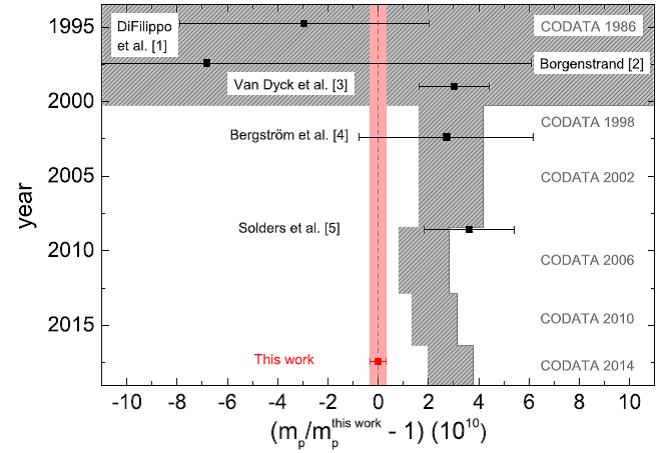
For details see
03/21/2017 Observation of single spin transitions of a single trapped antiproton
Today we have published a paper in Phys. Lett. B in which we report on the detection of individual spin quantum transitions of a single trapped antiproton in a Penning trap. The spin state determination is based on the unambiguous detection of axial frequency shifts which are induced by the spin transition in presence of a magnetic bottle. We have achieved a detection fidelity of 92.6 % and demonstrated spin state initialization with 99.9% fideltiy.

For details see
01/18/2017 Most precise measurement of the antiproton magnetic moment
Today our article on an improved measurement of the magnetic moment of the antiproton, with a fractional precision of 0.8 parts in a million, was published in Nature Communications (link is external). This is, so far, the culmination point of 10 years of dedicated work on proton and antiproton magnetic moment measurements. Previously, the magnetic moment of the antiproton has been extracted from exotic atom spectroscopy, with a fractional resolution on the 0.001-level. In 2013 the ATRAP collaboration published a 680-fold improved measurement using a single antiproton in a Penning trap. BASE was approved by CERN's research board in 2013 to contribute to this search. The result which is reported here follows the high-precision comparison of the antiproton-to-proton charge-to-mass ratio, and is the second fundamental physics measurement produced by BASE. By using the continuous Stern Gerlach effect in Penning traps, we performed non-destructive single-antiproton spin-transition spectroscopy to measure the particle's Larmor frequency. Combining this with measurements of the cyclotron frequency of the single trapped antiproton, the magnetic moment of the particle was obtained in units of the nuclear magneton, this ratio is also called "g-factor". Within the experimental uncertainties, our result (g/2)pbar=2.7928465(23) is consistent with our recent proton g-factor measurement (g/2)p=2.792847350(9), which supports the CPT invariance of the Standard Model. The result also improves constraints on coefficients of the prominent Standard Model extension by up to a factor of 22. The much more precise measurement of the proton magnetic moment was carried-out by using the double Penning trap technique. A logical next step is the application of this much more challenging technique as well to measure the antiproton magnetic moment. Together with very recent measurements carried out by ASACUSA and ALPHA, we are making rapid progress in our understanding of antimatter.

For details see
11/11/2016 Happy Birthday Antiprotons !!!
A crucuial device in the BASE multi-Penning trap system is a reservoir trap for antiprotons. This trap is loaded with a cloud of antiprotons provided by CERN's antiproton decelerator and methods were developed to extract single particles from this reservoir and to supply them to our high precision measurement traps. This allows BASE to continuously perform experiments with antiprotons, independent from accelerator maintenance and shutdown cycles. We have loaded the last bunch of antiprotons on the 12th of November 2015, still performing experiments with these particles
For details see09/20/2015 High-precision comparison of the antiproton-to-proton charge-to-mass ratio
In a paper published in Nature we report the high-precision comparison of the antiproton-to-proton charge to mass ratio. In our measurements we compared the cyclotron frequencies of antiprotons to that of negatively charged hydrogen ions, which are used as a proxy for the proton. We achieved a fractional precision of 69 parts in a trillion, which corresponds in our magnetic field of 1.95 Tesla to an absolute energy resolution of 2mHz. Our result is consistent with CPT invariance. We profited from ideas developed by the TRAP collaboration, which applied a comparable scheme already in the late 1990ies. In BASE, however, we established techniques which allow us to perform a single ratio comparison within only 4 minutes, which is much faster than in previous experiments. This enabled us to perform about 6500 ratio comparisons. The high sampling rate allowed us to study diurnal ratio-variations with high temporal resolution. The Standard Model of particle physics – the theory that best describes particles and their fundamental interactions – is known to be incomplete, inspiring various searches for “new physics” that goes beyond the model. These include tests that compare the basic characteristics of matter particles with those of their antimatter counterparts. While matter and antimatter particles can differ, for example, in the way they decay (a difference often referred to as violation of CP symmetry), other fundamental properties, such as the absolute value of their electric charges and masses, are predicted to be exactly equal. Any difference – however small — between the charge-to-mass ratio of protons and antiprotons would break a fundamental law known as CPT symmetry. This symmetry reflects well-established properties of space and time and of quantum mechanics, so such a difference would constitute a dramatic challenge not only to the Standard Model, but also to the basic theoretical framework of particle physics.

08/18/2014 Direct high-precision measurement of the proton magnetic moment
In a paper just published in Nature we report on the first direct high precision measurement of the proton magnetic moment. By application of the elegant double Penning trap technique we achieved a fractional precision of 3.3 parts per billion. Our value is consistent with the currently accepted CODATA value, but 2.5 times more precise.
The currently most precise value of the proton magnetic moment is based on spectroscopy of the ground state hyperfine splitting of atomic hydrogen in a magnetic field using a MASER. From these experiments, carried out about 42 years ago, the proton magnetic moment is extracted using input of two independent experiments and bound state corrections at the level of 17.7 ppm. In contrast, we measured the magnetic moment of a single trapped proton directly, which is about 760 times more precise than any direct measurement performed so far.
The double trap measuring-scheme can be directly applied to measure the magnetic moment of a single trapped antiproton, which is planned at the BASE-CERN experiment, currently being setup for the AD antiproton run 2014. The magnetic moment of the antiproton has recently been measured by the ATRAP collaboration with a fractional precision of 4.4ppm, which is 680 times more precise than values extracted from antiprotonic helium spectroscopy performed by the ASACUSA collaboration. In BASE we plan to apply the double trap scheme to improve the 4.4ppm value by more than a factor of 1000. This will constitute a stringent test of CPT invariance with baryons.
Andreas Mooser, first author of the paper, just joined the BASE-team at CERN. His post-doctoral research will be funded by one of the highly competitive RIKEN foreign post-doctoral researchers fellowships.

